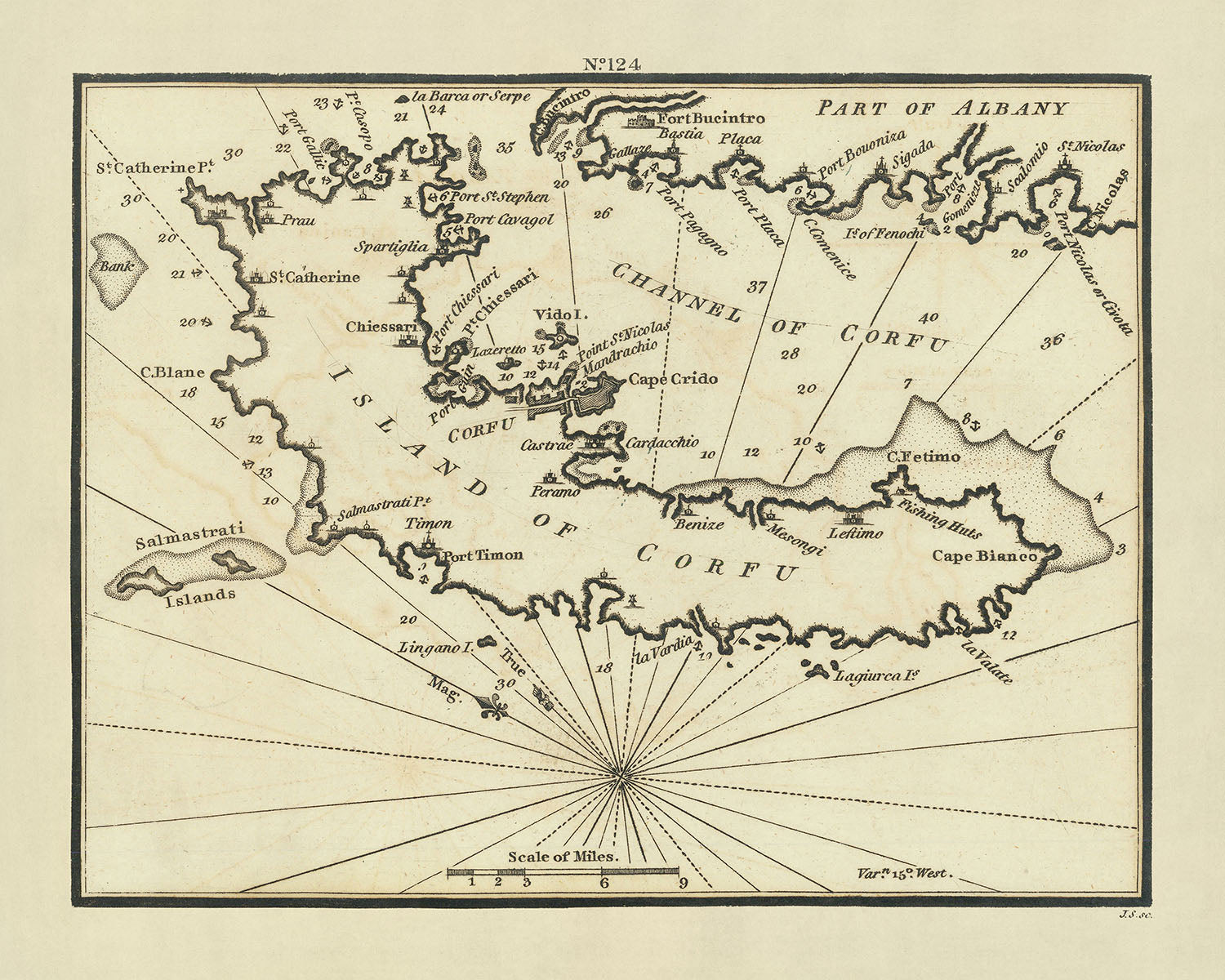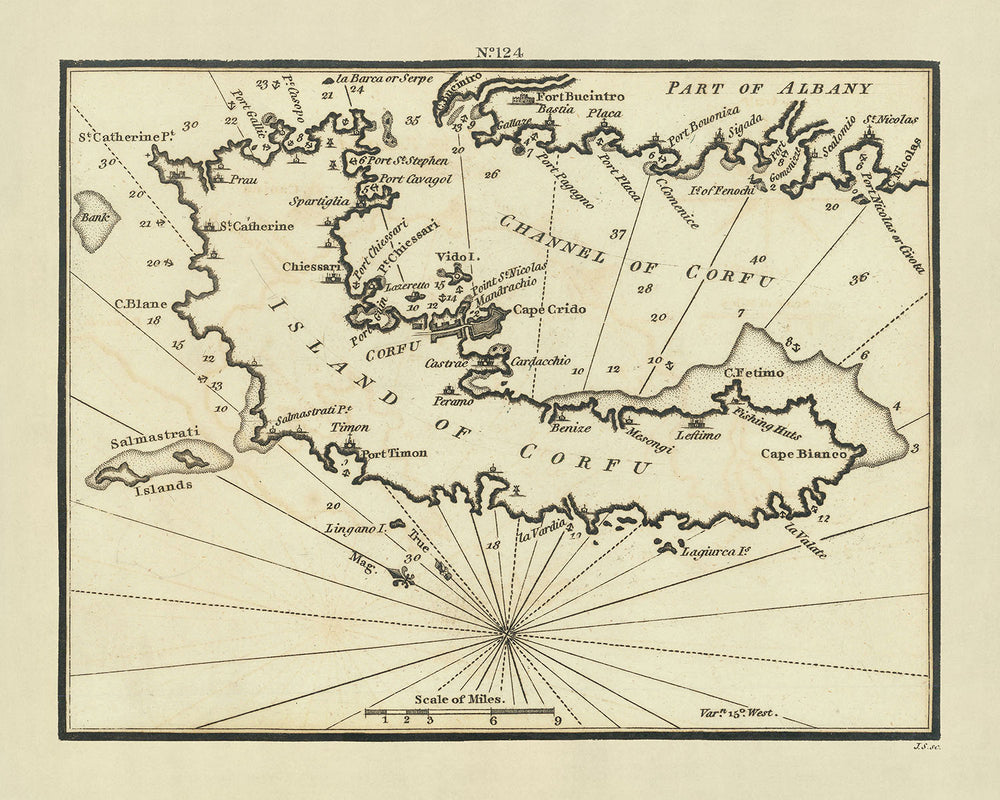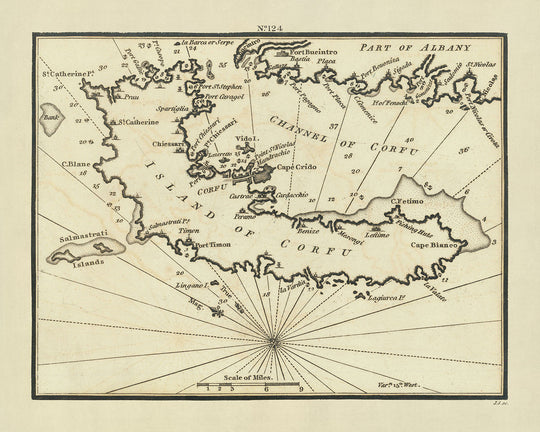- Handmade locally. No import duty or tax
- FREE Delivery by Christmas
- Love it or your money back (90 days)
- Questions? WhatsApp me any time
Own a piece of history
5,000+ 5 star reviews


Exquisite Cartographic Detail: The 1802 Chart of Corfu by William Heather
The 1802 chart titled "Island of Corfu" stands as a quintessential example of meticulous cartography by the renowned British hydrographer, William Heather. This rare chart, which graces the collection of Heather's seminal work, The New Mediterranean Pilot, delineates the strategic Ionian island of Corfu, along with the adjacent channel and the Albanian coast. The map is not merely a navigational aid but a rich historical document capturing the geopolitical and maritime significance of the region during the early 19th century. Heather's expertise in hydrography is evident in the precise soundings, anchorages, and navigational details that catered primarily to the needs of maritime pilots of the era.
Navigational Precision and Artistic Flair
Heather's chart is a masterpiece of both utility and aesthetics, characterized by its hand-colored engraving and detailed topographical portrayal. The orientation with northeast at the top is particularly intriguing, deviating from the conventional north-at-the-top orientation, which may reflect specific navigational practices of the time. The inclusion of soundings and detailed coastal features not only provided essential information for navigation but also highlighted Heather's commitment to accuracy and detail in his charts. The artistic flair is evident in the subtle coloring and the delicate rendering of the coastal outlines, making it not only a tool for navigation but also a work of art.
A Portal to the Past
This chart offers a window into the historical context of Corfu and its surroundings in 1802. At this time, Corfu was a pivotal maritime hub in the Ionian Sea, influenced heavily by Venetian, French, and British sovereignties over the centuries. The map meticulously marks significant landmarks such as Fort St. Stephen and Port Cavagol, echoing the Venetian architectural and maritime legacy. The depiction of tiny yet significant islands like Vido, Paxos, and Antipaxos further enriches the narrative, illustrating their roles in the maritime routes and defensive strategies of the era.
Heather's Legacy in Nautical Cartography
William Heather's contribution to nautical cartography is profoundly captured in this chart. As a prominent figure in the late 18th and early 19th centuries, Heather specialized in creating detailed maritime charts that were indispensable for safe navigation. His works, particularly those published in The New Mediterranean Pilot, are celebrated for their precision and reliability. This chart of Corfu is a testament to Heather's legacy, showcasing his skill in blending scientific accuracy with detailed craftsmanship, a hallmark that made his charts highly valued among seafarers and collectors alike.
Rarity and Collectible Value
The rarity of this chart amplifies its value significantly, making it a prized possession for collectors and historians. As noted, charts from Heather's The New Mediterranean Pilot are exceedingly rare, and this chart of Corfu is no exception. Its appearance on the market is a rare event, offering an exclusive opportunity for connoisseurs of cartography to own a piece of maritime history. The chart is not only a navigational tool but also a collectible artifact that captures the essence of an era when maritime exploration and cartographic precision were paramount in understanding and traversing the complex waters of the Mediterranean.
This chart, with its rich historical context and exquisite cartographic detail, is more than just a map; it is a bridge to the maritime past, crafted by one of the luminaries of nautical chart-making.
Notable Places on This Map
- The island of Corfu, located in the Ionian Sea.
- The town of Corfu, which is the capital of the island.
- The island of Vido, located just off the coast of Corfu.
- The island of Paxos, located to the south of Corfu.
- The island of Antipaxos, located to the south of Paxos.
Notable Features & Landmarks
- Fort St. Stephen, built by the Venetians in the 16th century to protect the island from Ottoman invasion.
- Port Cavagol, a major port on the island during the Venetian period.
Historical and Design Context
- Mapmaker/Publisher: William Heather, a British hydrographer known for his detailed charts and books on navigation.
- Published Date: 1802.
- Historical Significance: Provides a detailed snapshot of the Island of Corfu, the channel between Corfu and Albania, and the coast of Albania in 1802.
- Design or Style: Hand-colored engraving, oriented with northeast at the top, drawn in a detailed and realistic style.
- Part of: Heather's The New Mediterranean Pilot, an important work of nautical cartography from the late 18th and early 19th centuries.
- Rarity: Charts from Heather's The New Mediterranean Pilot are extremely rare on the market.
Please double check the images to make sure that a specific town or place is shown on this map. You can also get in touch and ask us to check the map for you.
This map looks great at every size, but I always recommend going for a larger size if you have space. That way you can easily make out all of the details.
This map looks amazing at sizes all the way up to 50in (125cm). If you are looking for a larger map, please get in touch.
The model in the listing images is holding the 16x20in (40x50cm) version of this map.
The fifth listing image shows an example of my map personalisation service.
If you’re looking for something slightly different, check out my collection of the best old maps to see if something else catches your eye.
Please contact me to check if a certain location, landmark or feature is shown on this map.
This would make a wonderful birthday, Christmas, Father's Day, work leaving, anniversary or housewarming gift for someone from the areas covered by this map.
This map is available as a giclée print on acid free archival matte paper, or you can buy it framed. The frame is a nice, simple black frame that suits most aesthetics. Please get in touch if you'd like a different frame colour or material. My frames are glazed with super-clear museum-grade acrylic (perspex/acrylite), which is significantly less reflective than glass, safer, and will always arrive in perfect condition.
This map is also available as a float framed canvas, sometimes known as a shadow gap framed canvas or canvas floater. The map is printed on artist's cotton canvas and then stretched over a handmade box frame. We then "float" the canvas inside a wooden frame, which is available in a range of colours (black, dark brown, oak, antique gold and white). This is a wonderful way to present a map without glazing in front. See some examples of float framed canvas maps and explore the differences between my different finishes.
For something truly unique, this map is also available in "Unique 3D", our trademarked process that dramatically transforms the map so that it has a wonderful sense of depth. We combine the original map with detailed topography and elevation data, so that mountains and the terrain really "pop". For more info and examples of 3D maps, check my Unique 3D page.
For most orders, delivery time is about 3 working days. Personalised and customised products take longer, as I have to do the personalisation and send it to you for approval, which usually takes 1 or 2 days.
Please note that very large framed orders usually take longer to make and deliver.
If you need your order to arrive by a certain date, please contact me before you order so that we can find the best way of making sure you get your order in time.
I print and frame maps and artwork in 23 countries around the world. This means your order will be made locally, which cuts down on delivery time and ensures that it won't be damaged during delivery. You'll never pay customs or import duty, and we'll put less CO2 into the air.
All of my maps and art prints are well packaged and sent in a rugged tube if unframed, or surrounded by foam if framed.
I try to send out all orders within 1 or 2 days of receiving your order, though some products (like face masks, mugs and tote bags) can take longer to make.
If you select Express Delivery at checkout your order we will prioritise your order and send it out by 1-day courier (Fedex, DHL, UPS, Parcelforce).
Next Day delivery is also available in some countries (US, UK, Singapore, UAE) but please try to order early in the day so that we can get it sent out on time.
My standard frame is a gallery style black ash hardwood frame. It is simple and quite modern looking. My standard frame is around 20mm (0.8in) wide.
I use super-clear acrylic (perspex/acrylite) for the frame glass. It's lighter and safer than glass - and it looks better, as the reflectivity is lower.
Six standard frame colours are available for free (black, dark brown, dark grey, oak, white and antique gold). Custom framing and mounting/matting is available if you're looking for something else.
Most maps, art and illustrations are also available as a framed canvas. We use matte (not shiny) cotton canvas, stretch it over a sustainably sourced box wood frame, and then 'float' the piece within a wood frame. The end result is quite beautiful, and there's no glazing to get in the way.
All frames are provided "ready to hang", with either a string or brackets on the back. Very large frames will have heavy duty hanging plates and/or a mounting baton. If you have any questions, please get in touch.
See some examples of my framed maps and framed canvas maps.
Alternatively, I can also supply old maps and artwork on canvas, foam board, cotton rag and other materials.
If you want to frame your map or artwork yourself, please read my size guide first.
My maps are extremely high quality reproductions of original maps.
I source original, rare maps from libraries, auction houses and private collections around the world, restore them at my London workshop, and then use specialist giclée inks and printers to create beautiful maps that look even better than the original.
My maps are printed on acid-free archival matte (not glossy) paper that feels very high quality and almost like card. In technical terms the paper weight/thickness is 10mil/200gsm. It's perfect for framing.
I print with Epson ultrachrome giclée UV fade resistant pigment inks - some of the best inks you can find.
I can also make maps on canvas, cotton rag and other exotic materials.
Learn more about The Unique Maps Co.
Map personalisation
If you're looking for the perfect anniversary or housewarming gift, I can personalise your map to make it truly unique. For example, I can add a short message, or highlight an important location, or add your family's coat of arms.
The options are almost infinite. Please see my map personalisation page for some wonderful examples of what's possible.
To order a personalised map, select "personalise your map" before adding it to your basket.
Get in touch if you're looking for more complex customisations and personalisations.
Map ageing
I have been asked hundreds of times over the years by customers if they could buy a map that looks even older.
Well, now you can, by selecting Aged before you add a map to your basket.
All the product photos you see on this page show the map in its Original form. This is what the map looks like today.
If you select Aged, I will age your map by hand, using a special and unique process developed through years of studying old maps, talking to researchers to understand the chemistry of aging paper, and of course... lots of practice!
If you're unsure, stick to the Original colour of the map. If you want something a bit darker and older looking, go for Aged.
If you are not happy with your order for any reason, contact me and I'll get it fixed ASAP, free of charge. Please see my returns and refund policy for more information.
I am very confident you will like your restored map or art print. I have been doing this since 1984. I'm a 5-star Etsy seller. I have sold tens of thousands of maps and art prints and have over 5,000 real 5-star reviews. My work has been featured in interior design magazines, on the BBC, and on the walls of dozens of 5-star hotels.
I use a unique process to restore maps and artwork that is massively time consuming and labour intensive. Hunting down the original maps and illustrations can take months. I use state of the art and eye-wateringly expensive technology to scan and restore them. As a result, I guarantee my maps and art prints are a cut above the rest. I stand by my products and will always make sure you're 100% happy with what you receive.
Almost all of my maps and art prints look amazing at large sizes (200cm, 6.5ft+) and I can frame and deliver them to you as well, via special oversized courier. Contact me to discuss your specific needs.
Or try searching for something!















































